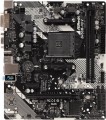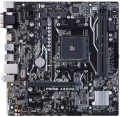Size (HxW)
Motherboard dimensions in height and width. It is assumed that the traditional placement of motherboards is vertical, so in this case one of the dimensions is called not the length, but the height.
Motherboard sizes are largely determined by their form factors (see above), however, the size of a particular motherboard may differ slightly from the standard adopted for this form factor. In addition, it is usually easier to clarify the dimensions according to the characteristics of a particular motherboard than to look for or remember general information on the form factor. Therefore, size data can be given even for models that fully comply with the standard.
The third dimension — thickness — is considered less important for a number of reasons, so it is often omitted.
Chipset
The chipset model installed in the motherboard. AMD's current chipset models are
B450,
A520,
B550,
X570,
A620,
B650,
B650E,
X670,
X670E,
B840,
B850,
X870,
X870E. For Intel, in turn, the list of chipsets looks like this:
X299,
H410,
B460,
H470,
Z490,
H510,
B560,
H570,
Z590,
H610,
B660,
H670,
Z690,
B760,
Z790,
H810,
B860,
Z890.
A chipset is a set of chips on the motherboard through which the individual components of the system inter
...act directly: the processor, RAM, drives, audio and video adapters, network controllers, etc. Technically, such a set consists of two parts — the north and south bridges. The key element is the northbridge, it connects the processor, memory, graphics card and the southbridge (together with the devices it controls). Therefore, it is often the name of the north bridge that is indicated as the chipset model, and the south bridge model is specified separately (see below); it is this scheme that is used in traditional layout motherboards, where bridges are made in the form of separate microcircuits. There are also solutions where both bridges are combined in one chip; for them, the name of the entire chipset can be indicated.
Anyway, knowing the chipset model, you can find various additional data on it — from general reviews to special instructions. An ordinary user, usually, does not need such information, but it can be useful for various professional tasks.1x PCI-E slots
Number of PCI-E (PCI-Express) 1x slots installed on the motherboard. There are
motherboards for 1 PCI-E 1x slot,
2 PCI-E 1x slots,
3 PCI-E 1x ports and even more.
The PCI Express bus is used to connect various expansion cards — network and sound cards, video adapters, TV tuners and even SSD drives. The number in the name indicates the number of PCI-E lines (data transfer channels) supported by this slot; the more lines, the higher the throughput. Accordingly, PCI-E 1x is the basic, slowest version of this interface. The data transfer rate for such slots depends on the PCI-E version (see "PCI Express Support"): in particular, it is slightly less than 1 GB / s for version 3.0 and slightly less than 2 GB / s for 4.0.
Separately, we note that the general rule for PCI-E is as follows: the board must be connected to a slot with the same or more lines. Thus, only single-lane boards will be guaranteed to be compatible with PCI-E 1x.
DVI output
The motherboard has its own
DVI output; this clause also specifies the specific form of this interface.
Such an output is intended for transmitting video from an integrated graphics card (see above) or a processor with integrated graphics (we emphasize that it is impossible to output a signal from a discrete graphics card through the motherboard chipset). As for DVI specifically, this is a standard originally created for digital video devices, however, it also allows an analogue signal format, depending on the type. In modern computer technology, including motherboards, you can find two types of DVI:
— DVI-D. A standard that provides for the transmission of a signal only in digital form. Depending on the supported mode, the maximum resolution of such video can be 1920x1200 (single-link Single Link) or 2560x1600 (two-channel Dual Link); however, Single Link plugs can be connected to Dual Link ports, but not vice versa. Also note that such connectors are compatible with HDMI via adapters, while in some cases even sound transmission may be provided (although this function is not initially supported in DVI-D, and its availability should be specified separately).
— DVI-I. A standard that combines the DVI-D described above with analogue DVI-A and allows the signal to be output in both digital and analogue formats. DVI-A in its characteristics corresponds to VGA (see above): it supports resolutions up to 1280x1024
...inclusive and allows you to connect VGA screens through a simple adapter.HDMI version
HDMI connector version (see above) installed in the motherboard.
— v.1.4. The earliest of the standards found nowadays, which appeared back in 2009. Supports resolutions up to 4096x2160 inclusive and allows you to play Full HD video with a frame rate of up to 120 fps — this is enough even for 3D playback.
— v.1.4b. A modified version of v.1.4 described above, which introduced a number of minor updates and improvements — in particular, support for two additional 3D formats.
— v.2.0. Also known as HDMI UHD, this version introduced full 4K support, with frame rates up to 60 fps, as well as the ability to work with 21:9 ultra-widescreen video. In addition, thanks to the increased bandwidth, the number of simultaneously reproduced audio channels has grown to 32, and audio streams to 4. And in the v.2.0a improvement, HDR support has also been added to all this.
— v.2.1. Another name is HDMI Ultra High Speed. Compared to the previous version, the interface bandwidth has really increased significantly — it is enough to transmit video at resolutions up to 10K at 120 frames per second, as well as to work with the extended BT.2020 colour space (the latter may be useful for some professional tasks). HDMI Ultra High Speed cables are required to use the full capabilities of HDMI v2.1, but older standard features are available with regular cables.
PS/2
The number of PS/2 ports provided in the design of the motherboard.
PS/2 is a dedicated port designed to connect exclusively to keyboards and/or mice. The traditional motherboard configuration for a PC provides 2 such ports — for the keyboard (usually highlighted in lilac) and for the mouse (green). However, there are boards with one connector, to which you can connect any of these types of peripherals, to choose from. Anyway, the presence of PS/2 can save the user from having to occupy USB ports for the keyboard / mouse; this is especially useful if you have to deal with a lot of other USB peripherals. On the other hand, for a number of reasons, this connector is considered obsolete and is used less and less; and PS/2 peripherals are produced mainly in the form of USB devices, additionally equipped with PS/2 adapters.

